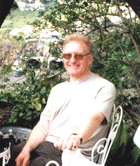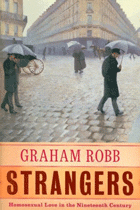 Tony Heyes (our man
from England) has submitted two more of his inimitable reviews for our
perusal and enjoyment— Tony Heyes (our man
from England) has submitted two more of his inimitable reviews for our
perusal and enjoyment— |
 Half-Life Half-Life by Aaron Krach Alison Books 2004 ISBN: 1-55583-845-5 Adam Westman is a gay teenager completing his final year of high school. He lives with his chronically depressed father, Greg, and his younger sister, Sandra. Their mother, Vivian, divorced Greg eight years ago because of his depression, and lives in a smart suburb with her new husband, Marc. She is pursuing a high-powered career. Her parenting skills seem minimal. Adam “hangs out” (where did this expression come from? Surely only bats, sloths and washing hang out?) with his two closest friends, Dart, another gay boy, and Fran, a lesbian. The burden of running the home, caring for Sandra and watching over his father falls on Adam, who is reduced to living the half-life of the title because of all these responsibilities. Early in the story Adam notices a stunningly handsome policeman getting out of his car. Their paths cross several times and they make eye contact. Each is intrigued by the other. Neither has any excuse to make a move towards the other until the most troubling point in the story, the death of Greg’s father. One night Adam feeds Greg a variety of sleeping pills and tranquillisers. He finds him dead in the morning. Whether it was assisted suicide, murder or manslaughter is up to the reader to decide. Greg wasn’t forced to take the tablets but, in his depressed state, was both vulnerable and suggestible. Adam, for his part, was exasperated and bearing a burden that ought properly to have been borne by one or other of his parents. Adam dials 911 and one of the policemen who come to investigate is the one whose image has been haunting him, Jeff Manfield. They now have the opportunity to talk. Jeff, who is twenty years older than Adam, rapidly moves their conversation from the official to the personal level. Subsequently Jeff has his suspicions about Greg’s death but does not pursue them and by the end of the story he and Adam have connected. This is a bare outline of the main plot. Along the way we are given insights into the lives of Jeff and his police partner, Sue, who has a crush on him, Adam’s mother and kindly stepfather, Marc, Fran and her partner and, most amusingly of all Dart (short for Dartagnan) and his budding relationship with a boy called James. They met at a science fair and their interaction is one of the more endearing parts of the novel. “Half-Life” is an unusual novel in that the main character, Adam, is the least sympathetic. Aaron Krach quite skilfully depicts a troubled young man made spiky and defensive by his circumstances. His relationship with Jeff, which might at first sight seem rather improbable, is depicted with great skill and is thoroughly plausible. The lives of the subsidiary characters are fleshed out sufficiently to place Adam firmly within a believable context. The world they inhabit is completely real, as is their tolerance of Adam’s moodiness. In addition, the quality of the writing is a joy in itself. Both the descriptive passages and the dialogue move the tale along at an enjoyable pace and contribute to one’s enjoyment. The plot is not the be all and end all of any novel; the telling is part of the pleasure and Mr. Krach has the story-teller’s gift. The moral ambiguities of Adam’s actions add to the book’s attraction and point up the messiness of any life by posing the question of how one plays the cards that life has dealt. This is a very satisfying and thought-provoking read. [On a purely personal and nit-picking note, I am puzzled by the passage on page 27: “Vivian’s little chow chow was yapping at nothing... he’s been acting snippy all day”. Whatever else chow chows do they do not yap, being generally silent and aloof. This is clearly one deeply disturbed and malnourished dog. When my partner and I bred them they averaged 70lbs. in weight and seldom made any noise. They would occasionally squeak with pleasure and barked only to order with a blood-curdlingly deep-throated bark]. Tony Heyes |
Visitors to the Empress Josephine’s Chateau at Malmaison are usually struck by two things. The first is the relative smallness of the building – it seems more like the country residence of the minor gentry than an Imperial Palace – and secondly by the theatricality of its interior decoration. It really does seem to be a stage set for the unfolding of the drama of Josephine’s life. Few people stop to think beyond this, yet an investigation into the lives of the designers is quite revealing. “Lives” because there were two designers, Charles Percier (1764 – 1838) and Pierre-Francois-Leonard Fontaine (1762 – 1853). Percier and Fontaine studied together at the French Academy in Rome, took a mutual vow never to marry, spent their lives together and were buried in the same grave. They were Napoleon’s official architects designing, among other things, the Arc du Carrousel, the Rue de Rivoli and the Chapelle Expiatoire in Paris. Clearly, the gay interior decorator is not simply a stereotype: he has a long, honourable and distinguished pedigree. Such backroom boys of history (although he does not mention this particular pair) are the raw material of Graham Robb’s book, “Strangers”, which is a compendious exploration of many aspects of homosexuality throughout the nineteenth century. Mr. Robb is already known for the excellence of his book on Rimbaud and this book maintains the same high standard. The title is apposite for, as the author demonstrates, throughout the nineteenth century gay people were, of necessity, strangers to the vast majority of the population. Given the depth of public prejudice, the arrogance of medical bigotry and the viciousness of the law, gay people had little alternative but to keep a low profile and pass as straight. Mr. Robb exhaustively catalogues the obstacles with which the nineteenth-century homosexual was faced and the lengths to which those in authority would go to eliminate the “problem”. The most culpable institutions of society were the Church, which then as now preached loving-kindness and practised condemnation and exclusion, and the medical profession which was ostensibly scientific but based its “findings” on a presumption of pathological abnormality. Only recently has the psychiatric profession admitted that homosexuality is not an illness. The infallible church, on the other hand, persists in regarding it as both a choice and a sin. Today, many gay people over-achieve in many fields and turn their backs on the Church in order to prove, on the “I’ll show the buggers” principle, just how misguided these organisations are. Mr. Robb is particularly entertaining in his analysis of nineteenth-century attitudes and their contradictions, especially medical models of “inversion”. Doctors seem to have seen themselves as dedicated seekers after truth when generally they were satisfying their own voyeurism and prurience. The tragedy is that for those forced to endure their ministrations and investigations there was little about them to amuse Despite the disapproval of society and the hostile machinery of the Establishment and the professions, gay people nonetheless managed to survive and carve out their own niches in society. Discretion and imperturbability enabled them to flourish, often in the highest levels of society. Percier and Fontaine were not the only example of homosexuals reaching the highest levels of their profession. Only the medicalisation of homosexuality as one of many categories of deviance caused such people to be given pejorative labels and created much greater difficulties than existed before. Whereas previously the expression “it goes without saying” had protected multitudes, now everything was said and people were exposed. On television a couple of years ago Elton John’s mother said “it all has to be talked about”. One’s initial response is – why must it be talked about? The alternative is not living in the closet so much as living and letting live. Mr. Robb ranges widely over all aspects of gayness in medicine, the law, literature and art as well as society at large. His “demonstration” that Sherlock Holmes and Dr. Watson were an item (we always knew that, didn’t we – just like Batman and Robin) and that Poe’s Dupin was gay is very amusing and compelling. Much of his material will be familiar to historically-minded readers but “Strangers” is a valuable drawing together of many strands, easy to read, comical and saddening in turns and very readable. It would be churlish to draw attention to omissions as the subject continues to expand. This book is a valuable addition to any bookshelf claimed to be comprehensive. Tony Heyes |

